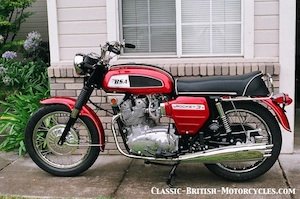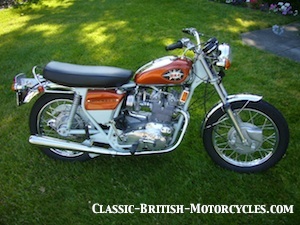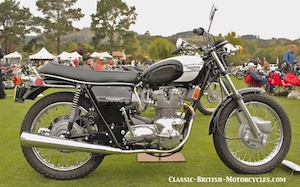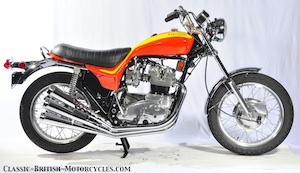TANGLED ROOTS
The BSA Rocket 3 is something of an anomaly in the history of BSA Motorcycles. Designed by Triumph, (BSA owned Triumph) in their Meriden Plant as the Triumph T150 Trident 750 triple, , and morphed into the BSA A65 Rocket 3, both were produced in BSA’s Small Heath factory.
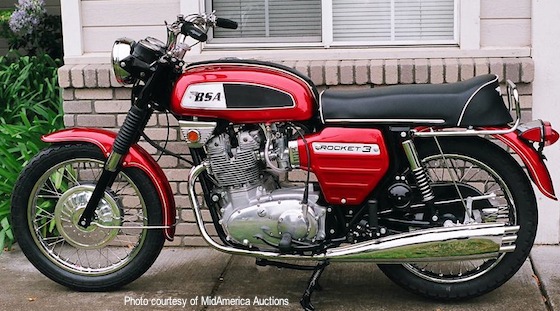
ABOVE: The 1969 BSA Rocket 3 hit the market with squarish “shoebox” fuel tank, slab-like side covers & laughable “ray gun” silencers. Sales suffered.
AHEAD OF THE CURVE?
The story of the BSA’s Rocket 3 & her sister-bike, the Triumph Trident, is one of the most interesting, and at the same time most exasperating, story in all the annals of Classic British Motorcycles. Interesting because the Rocket 3 & Trident might actually have been one of the few instances in which BSA might have actually been ahead of the curve with its planning. Exasperating because it took so many years to get from concept to prototype, then prototype to production, that the window of opportunity had closed. Now instead of an incomparably fast, radically new machine, by the time it launched in late 1968 (as a 1969 model), it had already been eclipsed by the world-beating Honda 750 Four.
BIRTH OF THE TRIPLE
As development work commenced on the soon-to-be-released unit construction Triumph twins, veteran Meriden engineers Herbert (Bert) Hopwood & Doug Hele saw the handwriting on the wall. As good as the 650 Triumph Bonneville was, it was already reaching its limits of performance & durability, and they were about to make it even faster! Vibration had become a problem as soon as they punched out the old 500cc Tiger T100 to create the 650cc Triumph 6T Thunderbird in 1950. It had gotten steadily worse as performance grew throughout the 1950s. The TR6 with its Delta head in 1956, followed by the twin-carb Bonneville in 1959 just made matters worse. Now that they were about to reintroduce the engine in unit-construction form, the goal was, of course, to extract even more power from it, to feed the hungry US market.
SOMETHING TOTALLY DIFFERENT
These talented designers came up a radical new idea. Instead of trying to balance a powerful big twin with a 360-degree crank, what if they split it between THREE cylinders, and arrayed the crankshaft with pins at every 120-degrees? In 1961, there were plenty of singles & twins, and even a few fours. But NO ONE had a triple! The idea was wild, especially considering the conservative nature of BSA & Triumph management at the time. But, by 1962 they had drawn up all the engine internals & by 1965 they had a running prototype engine in a 650 Bonneville frame.
HERE’S WHERE IT GOES SOUTH
Imagine, if you will, a BSA Rocket 3 750 Triple in 1966. What sort of impact would it have made in a marketplace filled with British 650 twins & a few 350s & a 450 twin out of Japan? Talk about being ahead of the curve! BSA would have had a bonafide hit on their hands & could have firmly established themselves as the preimminent performance brand. As it was, the Trident was the fastest production motorcycle in the world when it came out in 1968, even faster than the first Honda 750/4’s. Imagine that kind of performance 3 years ahead of the big Honda.
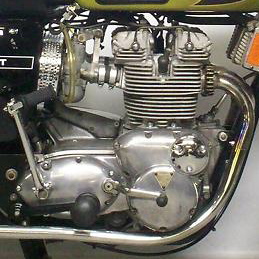 |
 |
The Triumph Trident engine (LEFT) with its vertical cylinders & the BSA Rocket 3 engine (RIGHT) with cylinders slanted at 12-degrees. The right side outer covers for timing chest & gearbox were different, each designed to reflect its lineage.
INTERNAL SQUABBLING
Well…it didn’t happen. Endless dithering on parent-company BSA’s part caused the project to run on indefinitely until the news of the impending release of the Honda 750/4 forced them into hasty action. You would think that after several years of tinkering with the bike prior to this, that they would have had something ready for market. But alas, not even close. First off, BSA was feeling slighted by Triumph’s popularity & success, and they wanted to do something for their dealers as well. So, the insisted that the new Triumph Trident triple also be made as a BSA, to be named the Rocket 3 (presumably to honor all those great pre-unit Rocket twins). But this wasn’t going to be some badge-engineered clone of the Trident. No, that would have made too much sense. Instead, they took all the basic internals, put them into an entirely new set of engine cases whose only purpose was to provide a 12-degree slant to the cylinders, to make it look different than the Triumph, which had vertical cylinders. But that wasn’t all. They dropped it into an entirely new frame, completely different than than the Trident unit. This ridiculous maneuvering slowed introduction even more & drove up costs.
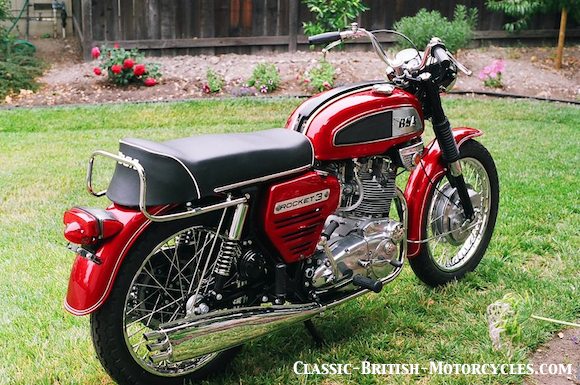
ABOVE: Excellent view of those crazy “Ray Gun” mufflers (silencers). Also known as “Flash Gordon” mufflers, an original set is highly- prized by collectors today. These actually turned out to be very good mufflers with excellent flow & long life.
AS IF THAT WEREN’T ENOUGH…
But BSA management wasn’t done screwing up the BSA Rocket 3 yet, or the Trident either, for that matter. Because they had come to the conclusion that this exciting new BSA must not look anything like their familiar BSA twins. So, they subcontracted-out the styling of the bikes to a firm that had never styled a motorcycle before. The Ogle company had built their reputation in industrial design, & particularly in the automotive business, having styled the Reliant Robin, among others. This further delayed the release & the final product was anything but beautiful. The new-for-1968 BSA Rocket 3 & Triumph Trident hit the market with a clunky fuel tank so square that it became known as the “shoebox tank”, along with slab-like side covers & mufflers (silencers) so outlandish they were nicknamed “Flash Gordon” or “Ray Gun” mufflers. Funny thing: they worked better than anything that came after.
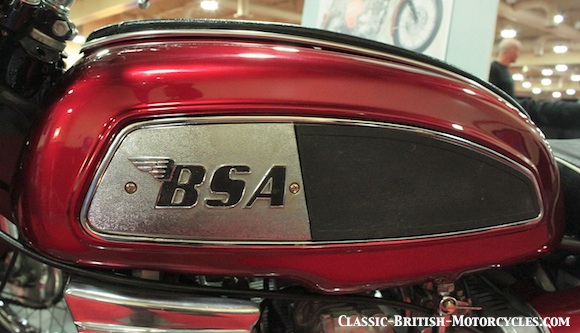
STYLING MISSES THE MARK
The radical styling simply didn’t do the bike justice & was roundly disliked by many. Styling can make or break a product & good styling doesn’t have to cost any more than poor styling. But it cost the Triumph Trident & the BSA Rocket 3 a great many sales in the critical early days, when they needed to be gaining market acceptance. By the time they got the styling right, 1971 for the Triumph Trident, it was too late & the window of opportunity had closed. The Honda 750/4 was stealing the limelight & the sales. In a desperate attempt to correct this blunder, Triumph came out with a dress-up kit that was sold through its dealers & could be dealer-installed or installed by the owner, that went a long way toward fixing the horrid styling. It included a new teardrop tank (in typical Triumph style), new convex side covers & a new set of conventional mufflers (silencers). While many kits were sold, it didn’t do much to shore up the weak sales of the Triumph Trident. The BSA Rocket 3 faired even worse. The styling of it’s twins hadn’t been all that popular lately anyway, so there wasn’t much they could do. They slowly changed the styling, until by 1971, they looked like proper pre-1971 BSA’s, chromed gas tanks and all.
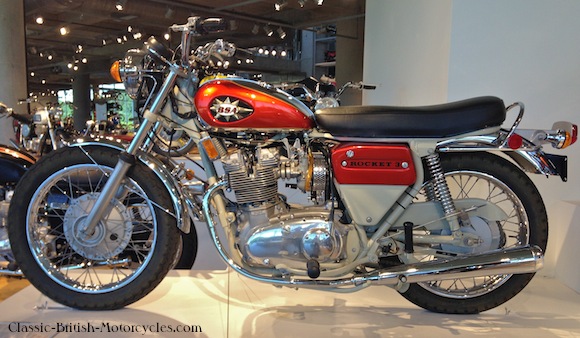
ABOVE: 1971 BSA Rocket 3, by now the “Shoebox”, the “Ray Guns” & the boxy side covers were replaced by more conventional pieces. The chrome tank with painted panels looks decidedly more BSA.
THE END OF BSA & THE BSA ROCKET 3
Unfortunately, BSA stumbled from one blunder into another, each time making its situation worse. After squandering millions on the overrated ‘technology center’ Umberslade Hall, all they got from it were more expensive mistakes, the aborted 350 Bandit & the dreaded Oil-in-Frame Twins in 1971, among others. When the 1971 BSA Rocket 3 came out, it benefited from the cycle gear of the oil-bearing twins, with new modern front forks & those cool-looking conical hubs front & rear. They also had conventional tanks, side covers & silencers, but it wasn’t enough to alter the course of destiny. BSA gasped its final breath in 1972. By this time, very few Rocket 3’s were being built. Many more Tridents were rolling off the assembly line at Small Heath, but not nearly enough for the ailing company to recover, or even make a profit. The last few 1972 BSA Rocket 3 ‘s had 5 speeds. As BSA teetered on the brink of total collapse, a deal was struck with Manganese Bronze Holdings, who also owned Norton & AMC and a new company was formed, Norton-Villiers-Triumph or NVT. At that point, BSA simply ceased to exist as a motorcycle company. The only remnant of it’s former great empire was Triumph Motorcycles, whose workers revolted & took control of the Meriden plant in 1974, became an employee-owned co-operative in 1975, then struggled along until they finally shut their doors in 1983. BSA, the once-great motorcycle company, a pioneer in the business, builder of the Gold Star, owner of Triumph, defense contractor, industrial giant was gone. In the final analysis, yes its management were afflicted with shortsightedness & arrogance, but it also suffered from corporate mishandling at the highest levels. At least we’ll always have these wonderful BSA motorcycles.
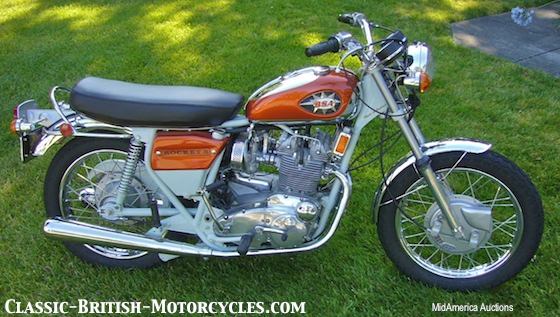
ABOVE: When you look at just how beautiful this 1971 BSA Rocket 3 really is, it makes you wonder why so few were sold. Of course, very few were made (part of BSA’s brilliant planning). This has got to be one of the finest examples remaining in captivity. Note that the frame has been painted a more pleasant (although not correct) non-metallic silver. The originals were more of a Dove Gray, slightly darker & muddier than this. However, I agree with his choice here, it looks great. It must have been very hard not to polish the hubs & brake plates. Those conical hubs look fantastic polished, but it wouldn’t be authentic! Overall, a brilliant execution of a very rare, very desirable machine.
BSA Rocket 3 YEAR-BY-YEAR
The radical new British triple hits the scene with its sibling the Triumph Trident with shoebox gas tanks & ray-gun mufflers, and just months ahead of the game-changing Honda 750-Four.
The Rocket inherits all the 1971 gear: conical hubs, new frame, forks, bodywork & pipes. The ugly duckling becomes a beautiful swan.
Sister bike to the BSA Rocket 3, their engines were the same except for the angle of the barrels. Frames also differed.
Yeah, I know…it’s not a BSA, right? But it started out as one & retains BSA Rocket 3 engine & frame. But by the time Craig Vetter got this wild factory custom done, BSA had closed, so it went to Triumph.
Check out these BSA BOOKS
BSA Motorcycles: The Final Evolution
The BSA Gold Star: Motorcycle History
Illustrated Bsa Buyer’s Guide (Motorbooks International Illustrated Buyer’s Guide)
BSA Unit Singles: The Complete Story including the Triumph Derivatives
Bsa Motor Cycles: Since 1950 (British Motor cycles since 1950)
BSA 500 & 650 Twins: The Essential Buyer’s Guide
How to Restore Triumph Trident T150/T160 & BSA Rocket III: YOUR step-by-step colour illustrated guide to complete restoration (Enthusiast’s Restoration Manual)
For more like these, visit our BSA BOOK STORE
 |
PLEASE BUY MY NEW E-BOOK HERE Click here to buy now: |



